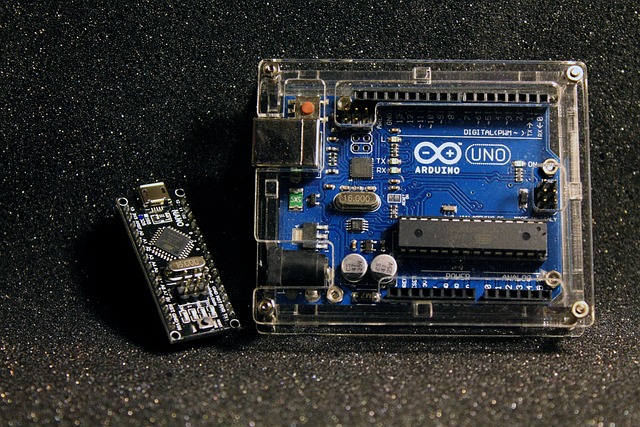Time: 2024-02-18 16:41:49View:
ARM microcontrollers are a type of integrated circuit (IC) that combines a central processing unit (CPU) based on the ARM architecture with various peripherals and memory, all within a single chip. The ARM architecture, developed by ARM Holdings, is widely used in the design of microprocessors and microcontrollers due to its low power consumption, versatility, and scalability.
Microcontrollers are small computer systems embedded into various electronic devices to control their operations. They are commonly used in products such as consumer electronics, industrial equipment, automotive systems, medical devices, and more. Microcontrollers differ from microprocessors in that they are designed for specific tasks and typically have integrated memory and peripherals, making them suitable for applications that require low power consumption, compact size, and cost-effectiveness.

ARM microcontrollers are widely favored in many applications due to their numerous advantages. However, it is important to acknowledge that they also come with a few limitations. Let's delve into the benefits and drawbacks of ARM microcontrollers:
1. Enhanced Power Efficiency: ARM microcontrollers are renowned for their energy efficiency, making them ideal for devices that rely on batteries or operate on low power. The ARM architecture is specifically designed to optimize power consumption, resulting in extended battery life and reduced overall energy usage.
2. Superior Performance: ARM microcontrollers offer exceptional performance capabilities, particularly those based on 32-bit processors. They deliver faster processing speeds, efficient instruction execution, and advanced features like pipelining and cache memory. These attributes make them well-suited for applications that demand complex computations and real-time processing.
3. Scalability Options: ARM microcontrollers provide a wide range of options, ranging from simple 8-bit microcontrollers to powerful 32-bit processors. This scalability empowers developers to select the most suitable microcontroller based on their application's specific requirements, effectively balancing performance, cost, and power consumption.
4. Extensive Ecosystem: ARM microcontrollers benefit from a robust ecosystem of development tools, software libraries, and community support. Multiple vendors produce ARM-based microcontrollers, resulting in a diverse array of options and features. The ARM architecture is supported by various development tools, compilers, and software libraries from different manufacturers, granting developers flexibility and access to abundant resources.
5.Versatility: ARM microcontrollers support a wide range of communication protocols and interfaces, including UART, SPI, I2C, USB, Ethernet, and wireless options like Bluetooth and Wi-Fi. This versatility enables seamless integration with other devices and systems, facilitating connectivity and communication in diverse applications.
Complexity: Working with ARM microcontrollers can be more intricate compared to simpler microcontroller architectures. The broader instruction set and advanced features may pose a steeper learning curve for developers, particularly those who are new to ARM-based development.
Cost: ARM microcontrollers, especially those with higher performance levels, tend to be pricier compared to some other microcontroller options. The additional functionality and performance capabilities come at an increased cost, which may be a factor to consider for projects with strict budget constraints.
Memory Requirements: ARM microcontrollers, especially those with 32-bit processors, may necessitate higher memory requirements compared to simpler microcontrollers. This can impact the overall system's cost and space requirements, particularly in applications with limited resources.
Real-Time Constraints: Although ARM microcontrollers offer real-time capabilities, they may not be as suitable for applications with extremely tight real-time constraints or hard real-time requirements. Depending on the specific application, specialized real-time microcontrollers or dedicated hardware may be more appropriate.
PIC and ARM microcontrollers are two different families of microcontrollers, and they have several differences in terms of architecture, instruction set, ecosystem, and application focus. Here are some key distinctions between the two:
1.Architecture and Instruction Set:
PIC Microcontrollers: PIC microcontrollers are based on the Harvard architecture, which separates program memory and data memory. They utilize a Reduced Instruction Set Computer (RISC) architecture with a fixed instruction set. PIC microcontrollers typically have 8-bit or 16-bit processors, with limited internal memory.
ARM Microcontrollers: ARM microcontrollers, on the other hand, are based on the von Neumann architecture, where program memory and data memory are combined. ARM microcontrollers utilize a more advanced RISC architecture and have a wider range of options, including 32-bit processors. They offer a larger instruction set and often include features such as pipelining and cache memory.
2.Performance and Complexity:
PIC Microcontrollers: PIC microcontrollers are known for their simplicity and ease of use. They are often used in applications that require a lower level of processing power and have less complex requirements. PIC microcontrollers are well-suited for simpler tasks and projects.
ARM Microcontrollers: ARM microcontrollers offer higher performance and are capable of handling more complex tasks. They are designed for applications that require more computational power, advanced features, and sophisticated algorithms. ARM microcontrollers are commonly used in applications such as robotics, industrial automation, and high-end consumer electronics.
3.Ecosystem and Development Tools:
PIC Microcontrollers: PIC microcontrollers have a dedicated ecosystem provided by Microchip Technology (formerly Microchip Technology Inc.). They offer a range of development tools, compilers, and software libraries specific to PIC microcontrollers. The MPLAB Integrated Development Environment (IDE) is commonly used for PIC microcontroller development.
ARM Microcontrollers: ARM microcontrollers benefit from a broader ecosystem and extensive industry support. Many vendors produce ARM-based microcontrollers, resulting in a wide variety of options and features. The ARM architecture is supported by multiple development tools, compilers, and software libraries from different manufacturers, providing developers with more flexibility in choosing their preferred tools.
4.Application Focus:
PIC Microcontrollers: PIC microcontrollers are often used in simpler projects and applications, such as home automation, basic sensing and control systems, small-scale robotics, and simple embedded systems. They are popular in educational settings and hobbyist projects due to their ease of use and lower cost.
ARM Microcontrollers: ARM microcontrollers find applications in a wide range of industries and products, including high-performance industrial automation, medical devices, automotive systems, advanced consumer electronics, Internet of Things (IoT) devices, and more. They are suitable for projects that require higher computational power, connectivity options, and advanced features.
In summary, PIC and ARM microcontrollers differ in their architecture, instruction sets, performance levels, ecosystem, and application focus. PIC microcontrollers are simpler, more straightforward, and often used in less complex applications, while ARM microcontrollers provide higher performance, advanced features, and a broader ecosystem, making them suitable for more demanding projects. The choice between the two depends on the specific requirements of the application and the desired level of complexity and performance.

ARM microcontrollers find applications in a wide range of industries and products due to their versatility, performance, and power efficiency. Some of the common applications for ARM microcontrollers include:
1. Consumer Electronics: ARM microcontrollers power numerous consumer electronic devices such as smartphones, tablets, smartwatches, and portable media players. Their high-performance capabilities and power efficiency make them ideal for driving the advanced features and user interfaces of these devices.
2. Internet of Things (IoT) Devices: ARM microcontrollers play a significant role in the development of IoT devices. They provide the necessary processing power and connectivity options to enable communication and control in smart home devices, wearables, industrial sensors, home automation systems, and other IoT applications.
3. Industrial Automation: ARM microcontrollers are widely used in industrial automation systems, including programmable logic controllers (PLCs), motor control systems, robotics, and factory automation. They offer the performance and real-time capabilities required for precise control and monitoring of industrial processes.
4. Automotive Systems: ARM microcontrollers are utilized in various automotive systems, including engine management, infotainment systems, advanced driver-assistance systems (ADAS), and in-car communication networks. They provide the necessary processing power and connectivity for automotive applications while meeting the strict requirements for reliability and safety.
5. Medical Devices: ARM microcontrollers are employed in medical devices such as patient monitoring systems, portable medical devices, infusion pumps, and diagnostic equipment. Their low power consumption, performance, and ability to interface with different sensors and communication protocols make them suitable for medical applications.
6. Home Automation: ARM microcontrollers are used in home automation systems to control and monitor various aspects of a smart home, including lighting, security systems, HVAC (heating, ventilation, and air conditioning), and smart appliances. They enable connectivity and communication between different devices and allow for remote control and automation.
7. Aerospace and Defense: ARM microcontrollers are utilized in aerospace and defense applications, including avionics systems, unmanned aerial vehicles (UAVs), navigation systems, and communication equipment. Their reliability, real-time capabilities, and power efficiency are essential in these demanding and mission-critical applications.
8. Energy Management: ARM microcontrollers contribute to energy management systems, such as smart meters, solar panel controllers, and energy monitoring devices. They enable efficient energy consumption monitoring, control, and optimization in residential, commercial, and industrial environments.
The versatility, performance, and scalability of ARM microcontrollers make them a popular choice in various industries where embedded systems and efficient processing are required.